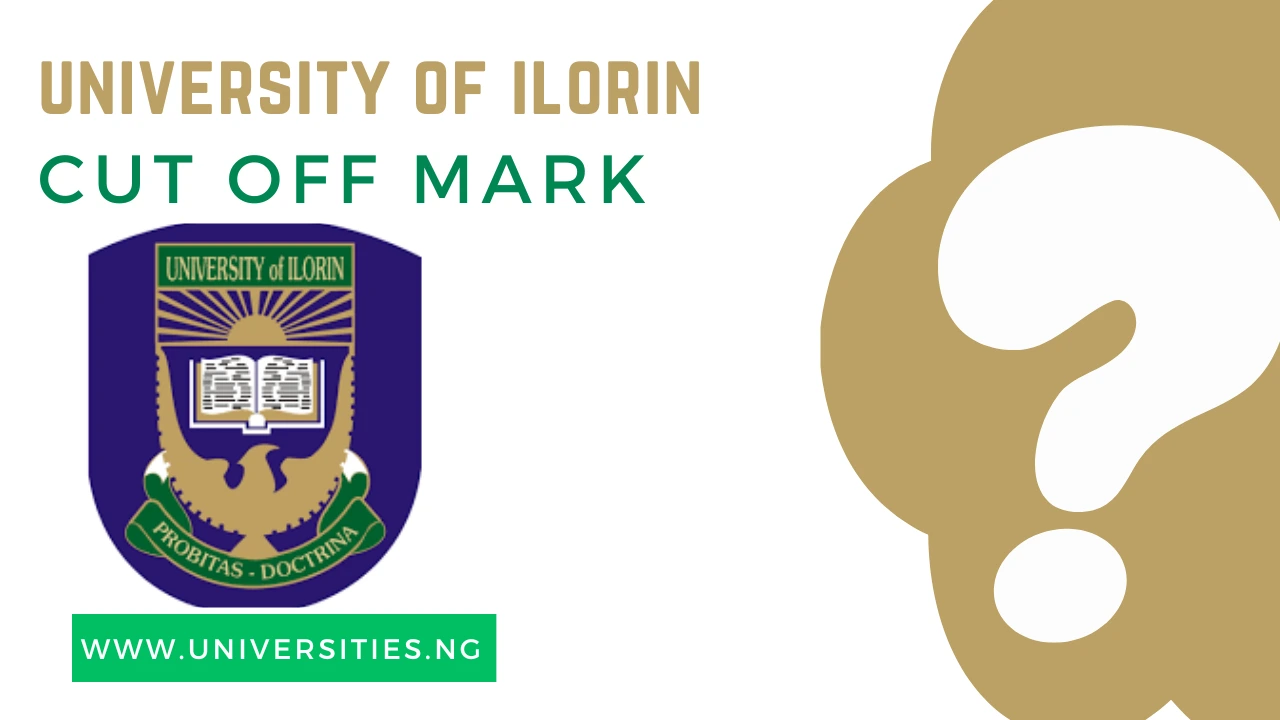The University of Ilorin (UNILORIN) is one of Nigeria’s most sought-after federal universities, which is known for academic excellence and a very competitive admission process. Admission is sought by thousands of students annually, but only those who meet the UNILORIN cut off mark stand a chance of being admitted.
The cut-off mark is an essential requirement in the UNILORIN admission process, as it determines eligible candidates for the post-UTME screening and further admission processes. Different courses have different departmental cut-off marks based on the competition, spaces available, and students’ performance.
This is a complete guide to UNILORIN’s cut-off mark for 2025/2026, including the JAMB cut off mark, departmental cut-off marks, post-UTME details, admission requirements, and what you can do if you don’t meet the cut-off mark.
What Is a Cut off Mark?
A cut off mark is the minimum score a candidate must get in JAMB and post-UTME to be eligible for admission into a university. Each university determines the cut off mark in line with JAMB requirements, departmental cut off , and competition for the available slots.
The approved 2025/2026 JAMB cut off mark for UNILORIN is 180 and above. That is, any candidate who has scored below 180 in JAMB (UTME) is not eligible to apply for admission at UNILORIN.
However, 180 does not guarantee admission to all courses. There are other courses with a higher departmental cut off mark, depending on competition and availability of spaces. Candidates who score both the JAMB and departmental cut off marks would have a greater chance of being admitted.
UNILORIN Cut Off Mark for All Courses (2025/2026)
Below is the list of departmental cut-off marks for different courses at UNILORIN:
Course | Cut-Off Mark |
|---|---|
Faculty of Agriculture | |
Agricultural Science and Education | 180 |
Agriculture | 200 |
Food Science | 200 |
Forestry and Wildlife Management | 180 |
Faculty of Arts | |
Arabic Studies | 180 |
Christian Studies | 180 |
Comparative Religious Studies | 180 |
English Language | 210 |
French | 180 |
Hausa | 180 |
History and International Studies | 210 |
Igbo | 180 |
Islamic Studies | 180 |
Linguistics | 200 |
Performing Arts | 190 |
Yoruba | 180 |
Faculty of Basic Medical Sciences | |
Anatomy | 220 |
Physiology | 220 |
Faculty of Clinical Sciences | |
Medicine and Surgery | 260 |
Faculty of Communication and Information Sciences | |
Library and Information Science | 180 |
Mass Communication | 240 |
Telecommunication Science | 200 |
Faculty of Education | |
Adult Education | 180 |
Business Education | 180 |
Computer Education | 180 |
Counsellor Education | 180 |
Education and Arabic | 180 |
Education and Biology | 180 |
Education and Chemistry | 180 |
Education and Christian Religious Studies | 180 |
Education and Computer Science | 180 |
Education and Economics | 180 |
Education and English Language | 190 |
Education and French | 180 |
Education and Geography | 180 |
Education and History | 180 |
Education and Islamic Studies | 180 |
Education and Mathematics | 180 |
Education and Physics | 180 |
Education and Social Studies | 180 |
Education and Yoruba | 180 |
Educational Management | 180 |
Educational Technology/Introductory Technology | 180 |
Health Education | 180 |
Human Kinetics | 180 |
Primary Education Studies | 180 |
Social Studies | 180 |
Technology Education | 180 |
Faculty of Engineering and Technology | |
Agricultural and Biosystems Engineering | 190 |
Biomedical Engineering | 200 |
Chemical Engineering | 230 |
Civil Engineering | 230 |
Computer Engineering | 240 |
Electrical and Electronics Engineering | 220 |
Food Engineering | 200 |
Mechanical Engineering | 230 |
Metallurgical and Materials Engineering | 200 |
Water Resources and Environmental Engineering | 200 |
Faculty of Environmental Sciences | |
Architecture | 220 |
Estate Management | 180 |
Quantity Surveying | 190 |
Surveying and Geoinformatics | 180 |
Urban and Regional Planning | 180 |
Faculty of Law | |
Common Law | 240 |
Common and Islamic Law | 230 |
Faculty of Life Sciences | |
Biochemistry | 220 |
Microbiology | 220 |
Plant Biology | 180 |
Zoology | 180 |
Faculty of Management Sciences | |
Accounting | 240 |
Business Administration | 220 |
Finance | 190 |
Marketing | 200 |
Public Administration | 200 |
Faculty of Pharmaceutical Sciences | |
250 | |
Faculty of Physical Sciences | |
Chemistry | 180 |
Computer Science | 220 |
Geology | 200 |
Industrial Chemistry | 200 |
Mathematics | 180 |
Physics | 180 |
Statistics | 190 |
Faculty of Social Sciences | |
Criminology and Security Studies | 180 |
Economics | 220 |
Geography and Environmental Management | 180 |
Political Science | 210 |
Psychology | 200 |
Social Work | 180 |
Sociology | 200 |
Faculty of Veterinary Medicine | |
Veterinary Medicine | 240 |
Admission Process & Requirements
UNILORIN admission process contains several steps:
1. JAMB UTME Examination
- Declare UNILORIN as the first choice in JAMB.
- Score a minimum of 180 and above (or pass the departmental cut off mark for a course).
2. O’Level Requirements
- Candidates must attain a minimum of five (5) credit passes in the following subjects: English Language and Mathematics.
- The result of O’Level should not be more than two sittings.
3. Post-UTME Screening
- Applicants with the JAMB cut off mark are required to register for UNILORIN Post-UTME.
- Screening involves online testing and checking of academic credentials.
4. Release of Admission List
- Admission is for candidates who succeed in the post-UTME and achieve the cut off mark.
- Admission status can be accessed through the JAMB CAPS portal or the UNILORIN admission portal.
Post-UTME Screening & Calculation of Aggregate Score
UNILORIN Post-UTME screening is required for all candidates. The screening process involves:
- Registration: The candidates must register online via the UNILORIN Post-UTME portal.
- Screening Fee: Non-refundable ₦2,000 – ₦3,000.
- Exam Format: The post-UTME exam consists of English, Mathematics, and three subjects related to the course.
How Aggregate Score is Calculated:
- JAMB Score (50%) + Post-UTME Score (30%) + O’Level Results (20%) = Final Aggregate Score
Applicants with high aggregate scores stand a better chance of being admitted.
How UNILORIN Determines Its Cut off Mark
UNILORIN fixes its cut off marks based on a range of factors, including:
- JAMB’s Benchmark: The university must maintain JAMB’s minimum score.
- Number of Applicants: Higher numbers of applications lead to higher cut off marks.
- Departmental Quotas: Each course has a fixed number of admission slots.
- General Performance of Candidates: Improved performance in JAMB means a higher cut off mark.
What To Do If You Don’t Meet the Cut off Mark
If you do not meet the cut off mark for your course, here are some alternatives for you:
1. Change of Course – Take less competitive courses.
2. Pre-degree/Foundation Program – Apply for UNILORIN’s pre-degree program.
3. Transfer to Another University – Some universities accept transfer students.
4. Retake JAMB – Study and retake the exam to boost your score.
Frequently Asked Questions (FAQs)
UNILORIN cut off mark is 180 and above.
No, the cut off mark for Pharmacy is 270.
No, UNILORIN admits first-choice candidates only.
The screening fee is ₦2,000 – ₦3,000.
Check the JAMB CAPS portal or UNILORIN admissions portal.
Yes, Direct Entry candidates are accepted by UNILORIN.
Yes, school fees range from ₦100,000 – ₦200,000 per session.
Yes, inter-university transfers are made at UNILORIN.
Yes, UNILORIN gives merit scholarships.
You might be eligible for less competitive programs.
Conclusion
It is very important to know the UNILORIN cut off mark for admission. Candidates should try to score higher in JAMB and post-UTME to get a better chance. For more admission information, check universities.ng. If you liked this guide, spread the word among other applicants!










